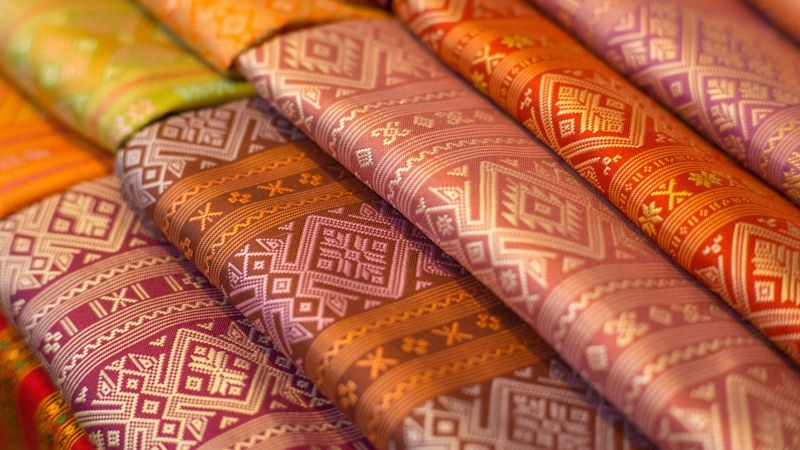Snapshots
Traditional Thai silk is highly prized and loved by many people across the world. The rich history and precise workmanship that went into its construction add to its attractiveness, along with its luxury feel and brilliant colours. Embracing its rich creative past, Thai silk fabric has come a long way from its modest origins to become a hallmark of Thai culture.
The beautiful variety of Thai Silk

Thai silk comes in a variety of varieties, each with its distinct qualities. Mulberry, wild, and tussah silk are the three most popular varieties of Thai silk. Soft and shiny, mulberry silk is Thailand's most popular silk kind. Produced from the cocoons of wild silkworms, wild silk—sometimes called ‘jungle silk’—is a more exclusive and costly kind of silk. Wild Tussah silk is characterised by its undulating colouration and coarse texture.
The rich history of Thai silk and the modern evolution

The establishment of the Kingdom of Sukhothai in what is now Thailand in the thirteenth century is the first known location of Thai silk production. Trade and cultural interchange probably brought the craft of silk manufacturing to Thailand from China and other regions of Asia, where it was already well-established at the time. The Royal Chronicles of Ayutthaya are the first surviving references to Thai silk; they detail the royal family's and the aristocracy's use of the fabric for apparel and other purposes.
The production and trade of Thai silk increased in tandem with Sukhothai's political and economic prosperity. Thai silk became famous for its beautiful colours, tenacity, and opulent suppleness, all of which attest to its high quality. It became an essential component of traditional Thai clothing, both men's and women's flowing pha nung and chong kraben, and of highly sought-after decorative items, such as tapestries and pillows, both at home and abroad.
When the Ayutthaya Kingdom was at its most powerful as a commercial centre in the 16th century, Thai silk was at the height of its fame. The skilled weavers and dyers of Ayutthaya were renowned for their vibrant use of natural dyes, insects, and plants to create a tapestry of colour. Tourists visiting renowned sites like Phuket, Bangkok, and Koh Samui sought-after souvenirs made of Thai silk, which became a valuable export treasured in Europe and throughout Asia for its flexibility in apparel, furnishings, and decorative arts.
The Thai silk industry encountered several obstacles in the late 19th and early 20th centuries. The demand for Thai silk declined as a result of the emergence of cheaper machine-made materials and the waning influence of the royal court and nobility, who had been major buyers of the cloth. Chemical dyes and other contemporary manufacturing methods also reduced the need for natural dyes, which were seen as clumsy and unreliable.
On the other hand, Thai silk saw a miniresurgence in the 1950s and 1960s. The Thai government, seeing the silk industry's cultural and economic significance, started to promote it as an attraction, which contributed to this. Another factor that contributed to the Thai silk industry's revival was the growing demand for high-quality, natural materials, which was fuelled by the fashion industry's meteoric ascent.
Thai silk- the fabric that has stood the test of time

The long lifespan and adaptability of Thai silk make it an attractive material with many potential uses. Modern fashion items and home furnishings are among its most prevalent uses, alongside traditional Thai clothes like the chong kraben (men's traditional outfit), the graceful pha nung (wrap-around skirt), and "chut thai" (traditional dress). Designers and discriminating customers throughout the globe love it for its brilliant shine and rich texture, which elevate any outfit or home décor.
How can I be a better consumer of Thai silk fabric?

Those who are looking to combine classic and modern styles may spruce up their outfits with Thai silk scarves or shawls. These items will elevate your style and bring out the fabric's remarkable elegance. They are perfect for both casual and formal occasions. Such accessories are the perfect way to highlight the one-of-a-kind beauty of Thai silk without drawing too much attention to yourself or your outfit.
Traditional crafts and environmental sustainability are both bolstered when eco-conscious consumers choose sustainable materials like Thai silk for garment designs. By highlighting the material's inherent beauty without compromising on ethics or style, designers are crafting heirloom-quality items from this precious resource. Adding Thai silk to modern garments is a great way to promote sustainable fashion practices while also blending heritage and flair.


_1731163710136_thumb_1200.jpeg?w=3840&q=75)
_1731161516732_thumb_300.jpeg)
